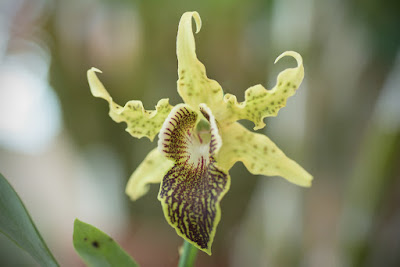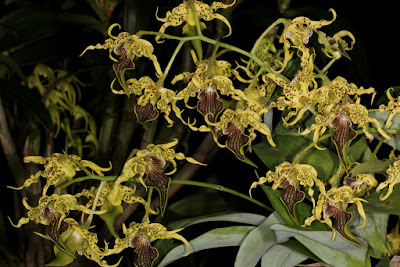Dendrobium alexandrae is native to Northeastern Papua New Guinea, in the District of Morobe. The reference plant was found in the Valley of Waria near Gobi (Gobe), at an altitude of 900-1100 m. It grew in cool, shady conditions on trees covered with moss in a damp forest.
Dendrobium alexandrae, also called as Alexandra's Dendrobium, Latourea alexandrae, Latourorchis alexandre, Sayeria alexandrae, is a species of the genus Dendrobium. This species was described by Rudolf Schlechter in 1912.
IDENTIFY DENDROBIUM ALEXANDRAE
Dendrobium alexandrae is native to Northeastern Papua New Guinea, in the District of Morobe. The reference plant was found in the Valley of Waria near Gobi (Gobe), at an altitude of 900-1100 m. It grew in cool, shady conditions on trees covered with moss in a damp forest.
It is a medium to large sized, cool growing epiphyte, which reaching 50-70 cm in height, with stems carrying 2 to 3 apical, elliptic, bluish-green, erect or spreading, 10-15 cm long leaves.
Alexandra's Dendrobium blooms on an axillary, racemose, laxly, several flowered inflorescence arising from the nodes at the apex of the pseudobulb occurring in the fall. These large flowers are 5-8, less often 10 cm in diameter. Lancet petals of both whorls are pale yellow. The edges of inner whorl flakes have curled edges. The tops of the outer whorls are slightly curved. The white lip has three plots, a thickening with short, fleshy edges and a sharp central plot. The flowers are marked with dark purple spots, in contrast to the thick red lines on Dendrobium spectabile.
DENDROBIUM ALEXANDRAE CARE AND CULTURE
Cultural information should only be used as a guide, and should be to be adapted to suit you. Your physical location; where you grow your plants, how much time you have to devote to their care, and many other factors, will need to be taken into account. Only then can you decide on the cultural methods that best suit you and your plants.
Light:
Dendrobium alexandrae needs a light level of 20000-30000 lux. From spring to autumn, the plants may needs slightly shade.
Temperature:
It is a thermophilic plant. Throughout the year the average day temperature is 25-28 ° C, night 16-17 ° C, giving a daily difference of 10-12 ° C.
Humidity:
This species needs a humidity of 80-85% throughout the year.
Substrate, growing media and repotting:
Dendrobium alexandrae can be mounted on tree fern washers if the height is high and watering is possible at least once a day during the summer. If you grow them in pots, you should use bark with a medium granulation, provided that the humidity is high. The substrate should hold moisture, but not let it out. The perfect drainage and strong air movement are very important. Repotting can be done when new roots start growing.
Watering:
Water is abundant throughout the year, but in the winter it is a bit drier. Cultivated plants should be kept in constant humidity, but not in a moistened substrate.
Fertilizer:
Weekly or every 2 weeks use of a 1/4-1/2 dose of orchid fertilizer is recommended. Balanced fertilizer should be used for a round year.
Rest period:
In winter, watering and fertilizing of Dendrobium alexandrae should be slightly reduced, especially those that are grown in the conditions of a short, dark day, but they should never dry up completely.















COMMENTS